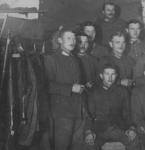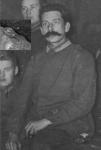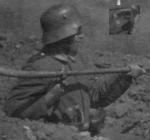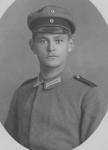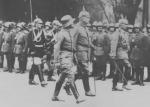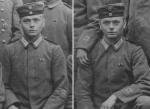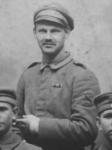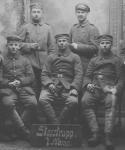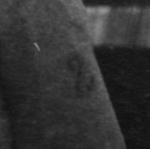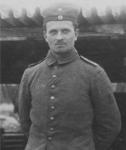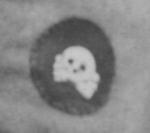
Thomas W
For Deletion-
Posts
788 -
Joined
-
Last visited
-
Days Won
3
Content Type
Profiles
Forums
Blogs
Gallery
Events
Store
Everything posted by Thomas W
-
Robin, when I get my photos back from my publisher, I'll post a scan of the flamethrower pioneer wearing the very dark Totenkopf. You can see his hand on the shoulder of another man on right of this image. I wish I'd scanned the whole image. It didn't occur to me that there might be a black Totenkopf sleeve badge. I thought it was just very dark gray.
-
Just found this: NOTES ON RECENT OPERATIONS JULY, 1917 WASHINGTON, GOVERNMENT PRINTING OFFICE WAR DEPARTMENT Document No. 630 Office of The Adjutant General The noncommissioned officers and privates who form a [German] battalion of assault are specially selected. They are young, strong, single men, or married men without children. Sometimes even the more unruly or undisciplined men of the company are taken. (From statements of prisoners.) The drafts from some companies have amounted to 25 men. The best of them have remained with the battalion after a course of training, which lasts six weeks; the others are sent back to their organizations, where they form platoons of assault or patrols when needed to execute raids. Under certain conditions these platoons may be united into one company of assault by infantry brigade; the companies in their turn may form a battalion of assault for an army corps. http://www.archive.org/stream/notesonrecen...itrich_djvu.txt
-
Chip, I have two photos of many of the same men. They're from the Experimental Company (Versuchs-Kompagnie) of the Garde-Reserve-Pionier-Regiment. Here's full photo No. 1. The only uniform anomaly, other than the ones in the outfit of Mr. Mustache, is on the man standing far left. He wears a Bluse with the short white Litzen mandated in March of 1915. The Litzen should be gray.
-
Robin, I've learned through my research to never say never. Just because we've yet to find official documentation of black-skull sleeve badges doesn't mean they weren't issued. And who's to say some unit didn't make up its own badges or decide to modify regulations as it saw fit? Look at this flamethrower pioneer: He's wearing an M.1915 Bluse with long, old-style white Litzen, and his shoulder strap is field gray with a cypher on it--a crown, maybe. The strap should be black piped in red, and what's a Guard Pioneer doing with a crown on his shoulder strap? It shouldn't be! Yet there it is.
-
Indeed. Possibly the weirdest flamethrower of the war was the Russian Tilly-Goskin, which I've included in my upcoming book. It was a tiny thing about 22 inches tall by 6 inches in diameter, with a swiveling rigid lance on the left side. It was also equipped with a hand pump to compress atmospheric air into an internal chamber; the igniter consisted of a mailbox-shaped container filled with inflammable liquid that was lit with a match; and the lance had--wait for it--a bayonet! Yup. For when the flamethrower sapper ran out of fuel. Charge! If that weren't bizarre enough, both the lance and the hand-pump handle were on the left side of the flamethrower, requiring the sapper to reach across his body with his right hand to hold the lance while he pumped the air into the propellant chamber. Needless to say this was not a successful weapon, even though records indicate that it was fielded and used in combat. Here's my drawing of the Tilly-Goskin, based on a photo and a detailed description in a Russian document.
-
The badge was unofficial, so there are many different styles. They vary in size, too. Here's something maybe people can help me with: In this photo of a Rohr flamethrower squad, the lance operator (Rohrf?hrer) has a field cap tucked into his belt. The cap has some kind of badge on it, very similar to an Austrian assault-troop badge. Can anybody identify it? I copied and pasted it into the upper right corner of the photo, after turning it 90 degrees.
-
Thanks. I've always thought it made more sense to share a little and show people that you've got the the goods rather than say "No! Mine!" The new book has over 300 photos and illustrations, so I don't think I'm detracting from its value. Also, I have no control over how the photos are printed in the book. That's up to the editor. Here, I can zoom in and blow up images to my heart's content.
-
But! He survived the war and apparently found happiness. This is the back of the postcard I just showed you. For those of you who can't read German, it says something like: "My Little Heart! At the time this photo was taken we unfortunately had not met. My heart did not know that it would overcome the war and... find you. Your darling." Probably not the right temperament for a flamethrower operator, eh?
-
Here's the same man as a member of the flamethrower platoon of Sturmbataillon Nr. 5 (Rohr). I know this because I've seen a photo of him wearing a Totenkopf sleeve badge in the "Rohr" position under the elbow. It's not my photo, unfortunately, so I can't post it. Note the subtle changes in his face, brought about by the strain of combat, no doubt.
-
I said I'd stop, but I lied! Ha-ha-ha-haaaaaaa! Here are two of my favorite images from my collection. First, is a Rohr flamethrower pioneer as a member of the II. Garde-Pionier-Ersatz-Bataillon, wearing his full parade finery. Note the fullness of his cheeks. This was before he joined the assault battalion.
-
On the far left of the photo are troopers from Sturmbataillon Nr. 5 (Rohr) and the Garde-Reserve-Pionier-Regiment. You can see the light-colored blob of the crown badge worn above the cuff by Rohr's man (left), and you can see the Totenkopf sleeve badge, Garde-Litzen, and black shoulder straps worn by the flamethrower pioneer (right). The Rohr pioneer also wears black shoulder straps. I don't know if this is some kind of honor guard, or if it was taken after a Maschinenpistole Kursus, since there are men from many units in the line of submachine gunners. Until I found this photo I didn't know that either Rohr's battalion or the flamethrower regiment were armed with submachine guns. Sorry my photo isn't better. I've seen only one other image of the Rohr sleeve badge, which is owned by a French collector named Maurice Sublet. The badge consisted of a crown above a letter "W," both in white metal, attached to an oval of field-gray cloth. Like the Rohr flamethrower badge, it was worn below the elbow.
-
Naxos, I have one very unclear photo of the Rohr arm badge, but it's interesting for many reasons. It shows Kaiser Wilhelm II and General Oskar von Hutier inspecting Stosstruppen armed with the MP18-1 submachine gun. Each soldier has a submachine gun and a trench knife, and he carries spare ammunition drums in the pockets of his Bluse:
-
Just to put the finishing touch on Rohr flamethrower pioneers, here's a closeup of a photo that will appear in my new flamethrower book, which Schiffer will publish sometime this year, I hope. This is the Truppf?hrer of a Kleiftrupp of Sturmbataillon Nr. 5 (Rohr), photographed at Malancourt in 1917. As you can see, he wears the Garde-Pionier uniform, but he also has a red "5" on his shoulder strap. All the other Rohr flamethrower pioneers in this photo have a "5" on their straps, too, so I'm pretty sure it was standard. If you look closely at the previous image I posted, it looks like the man has a "5" on his strap as well. I'll bet Reddemann hated that...
-
Chip, although I've been unable to find an actual written order, a series of photos of Rohr's battalion training in Beuville show that all his flamethrower troops wore their badges directly under the left elbow. Some of these photos appear on page 65 of M. Christian Ortner's Storm Troops: Austro-Hungarian Assault Units and Commandos in the First World War (Vienna: Verlag Militaria, 2005). I have over a dozen photos in my collection that show flamethrower pioneers wearing the sleeve badge in the "Rohr" position. The two most important when it comes to this issue are images that show men from the flamethrower platoon of Sturmbataillon Nr. 14. The first was taken on May 19, 1918, and the second on August 9, 1918. In the May photo, one flamethrower pioneer wears his badge in the "Rohr" position (left). In the August photo, he has moved it down to the "Reddemann" position (right) and put it on a bigger cloth backing. Major Reddemann, the commander of the flamethrower regiment, never once mentioned Rohr in his memoirs. I think there was some kind of rivalry between the two men. In addition, the 14 flamethrower pioneers of Rohr's battalion who died in the war are not recorded in the death book of the Garde-Reserve-Pionier-Regiment, indicating that they were not considered part of the regiment when they served with Rohr. Flamethrower pioneers serving with the other assault battalions were recorded in the regimental death book when they died, but not the men in Rohr's unit. I have photographic evidence that men transferred from Rohr's battalion into the flamethrower regiment, but not vice versa. Rohr got his replacements from the II. Garde-Pionier-Ersatz-Bataillon, as did Reddemann. So, Rohr's men wore the sleeve badge at the elbow to differentiate themselves from Reddemann's men, but when Rohr's men transferred into Reddemann's unit, they moved the badge to the lower postion.
-
Here's a closeup of the man in the center. He has a white Totenkopf sleeve badge, which has replaced his wartime version, but he wears it directly under the left elbow instead of on or above the cuff. This identifies him as belonging to the flamethrower platoon of Sturmbataillon Nr. 5 (Rohr). Note his black pioneer shoulder straps.




